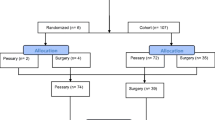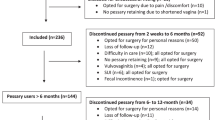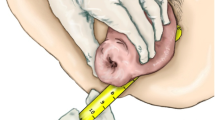Abstract
Introduction and hypothesis
The aim of this study is to evaluate and compare the effectiveness of pessaries and surgery in women with symptomatic pelvic organ prolapse.
Methods
A total of 554 women with symptomatic pelvic organ prolapse (POP) were recruited and treated with either a vaginal pessary (n = 359) or surgery (n = 195). Using the validated Sheffield POP questionnaire, outcomes were evaluated and then compared at 1 year.
Results
At 1 year, the only significant difference between the two groups was increased frequency of intercourse in the surgery group (54% vs 46%; p = 0.028), which was not significant when controlled for age. There was a statistically significant improvement in prolapse, urinary, bowel, and sexual function in both pessary users and those treated surgically.
Conclusions
One year after treatment, women with POP report similar improvement in urinary, bowel, sexual function, and quality of life parameters when treated with pessary or surgical correction.

Similar content being viewed by others
References
Olsen AL, Smith VJ, Bergstrom JO, Colling JC, Clark AL (1997) Epidemiology of surgically managed pelvic organ prolapse and urinary incontinence. Obstet Gynecol 89:501–506
Digesu GA, Chaliha C, Salvatore S, Hutchings A, Khullar V (2005) The relationship of vaginal prolapse severity to symptoms and quality of life. BJOG 112:971–976
Clemons JL, Aguilar VC, Tillinghast TA, Jackson ND, Myers DL (2004) Patient satisfaction and changes in prolapse and urinary symptoms in women who were fitted successfully with a pessary for pelvic organ prolapse. Am J Obstet Gynecol 190:1025–1029
Fernando RJ, Thakar R, Sultan AH, Shah SM, Jones PW (2006) Effect of vaginal pessaries on symptoms associated with pelvic organ prolapse. Obstet Gynecol 108:93–99
Komesu YM, Rogers RG, Rode MA, Craig EC, Gallegos KA, Montoya AR et al (2007) Pelvic floor symptom changes in pessary users. Am J Obstet Gynecol 197:620.e1–620.e6
Kuhn A, Bapst D, Stadlmayr W, Vits C, Mueller M (2009) Sexual and organ function in patients with symptomatic prolapse: are pessaries helpful? Ferti Steril 5:1914–1918
Adams EJ, Thomson AJM, Maher C, Hagen S (2004) Mechanical devices for pelvic organ prolapse in women. Cochrane Database Syst Rev (2):CD004010
Maher C, Baessler K, Glazener CMA, Adams EJ, Hagen S (2007) Surgical management of pelvic organ prolapse in women. Cochrane Database Syst Rev (3):CD004014. doi:10.1002/14651858.CD004014.pub3
Subak LL, Waetjen LE, van den Eeden S, Thom DH, Vittinghoff E, Brown JS (2001) Cost of pelvic organ prolapse surgery in the United States. Obstet Gynecol 98:646–651
Bash KL (2000) Review of vaginal pessaries. Obstet Gynecol Surv 55:455–460
Kapoor DS, Thakar R, Sultan AH, Oliver R (2009) Conservative versus surgical managment of prolapse: What dictates patient choice? Int Urogynecol J Pelvic Floor Dycfunct 20:1157–1161
Bradshaw HD, Hiller L, Farkas AG, Radley S, Radley SC (2006) Development and psychometric testing of a symptom index for pelvic organ prolapse. J Obstet Gynaecol 26:241–252
Baden WF, Walker T (1992) Surgical repair of vaginal wall defects. Lippincott, Philadelphia
Powers K, Lazarou G, Wang A, La Combe J, Besinger G, Greston WM et al (2006) Pessary use in advanced pelvic organ prolapse. Int Urogynecol J Pelvic Floor Dysfunct 17:160–164
Hullfish KL, Bovbjerg VE, Gurka MJ, Steers WD (2008) Surgical versus nonsurgical treatment of women with pelvic floor dysfunction: patient centered goals at 1 year. J Urol 179:2280–2285
Hullfish KL, Bovbjerg VE, Steers WD (2007) Colpocleisis for pelvic organ prolapse: patient goals, quality of life, and satisfaction. Obstet Gynecol 110:341–345
Schaffer J, Cundiff GW, Amundsen CL, Bent A, Coates KW, Strohbehn K et al (2006) Do pessaries improve lower urinary tract symptoms? J Pelvic Med Surg 12:72–73
Fourth International Consultation on Incontinence (ICI)—5–8 July 2008, Palais des Congres, Paris, France
Clark AL, Gregory T, Smith VJ, Edwards R (2003) Epidemiologic evaluation of reoperation for surgically treated pelvic organ prolapse and urinary incontinence. Am J Obstet Gynecol 189:1261–1267
Fialkow M, Symons RG, Flum D (2008) Reoperation for urinary incontinence. Am J Obstet Gynecol 199:546.e1–546.e8
Fialkow MF, Newton KM, Weiss NS (2008) Incidence of recurrent pelvic organ prolapse 10 years following primary surgical management: a retrospective cohort study. Int Urogynecol J Pelvic Floor Dysfunct 19:1483–1487
Vakili B, Zheng YT, Loesch H, Echols KT, Franco N, Chesson RR (2005) Levator contraction strength and genital hiatus as risk factors for recurrent pelvic organ prolapse. Am J Obstet Gynecol 192:1592–1598
Wiskind AK, Creighton SM, Stanton SL (1992) The incidence of genital prolapse after the Burch colposuspension. Am J Obstet Gynecol 167:399–404
Kjolhede P, Noren B, Ryden G (1996) Prediction of genital prolapse after Burch colposuspension. Acta Obstet Gynecol Scand 75:849–854
Lambrou NC, Buller JL, Thompson JR, Cundiff GW, Chou B, Montz FJ (2000) Prevalence of perioperative complications among women undergoing reconstructive pelvic surgery. Am J Obstet Gynecol 183:1355–1358
Stepp KJ, Barber MD, Yoo EH, Whiteside JL, Paraiso MF, Walters MD (2005) Incidence of perioperative complications of urogynecologic surgery in elderly women. Am J Obstet Gynecol 192:1630–1636
Sung VW, Weitzen S, Sokol ER, Rardin CR, Myers DL (2006) Effect of patient age on increasing morbidity and mortality following urogynecologic surgery. Am J Obstet Gynecol 194:1411–1417
Acknowledgement
We wish to thank IUGA for granting Dr. Z Abdool (Dept Obstetrics & Gynaecology, University of Pretoria, South Africa) the International Fellowship award—2008
Conflicts of interest
None.
Author information
Authors and Affiliations
Corresponding author
Rights and permissions
About this article
Cite this article
Abdool, Z., Thakar, R., Sultan, A.H. et al. Prospective evaluation of outcome of vaginal pessaries versus surgery in women with symptomatic pelvic organ prolapse. Int Urogynecol J 22, 273–278 (2011). https://doi.org/10.1007/s00192-010-1340-9
Received:
Accepted:
Published:
Issue Date:
DOI: https://doi.org/10.1007/s00192-010-1340-9




